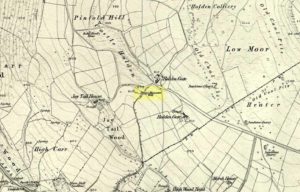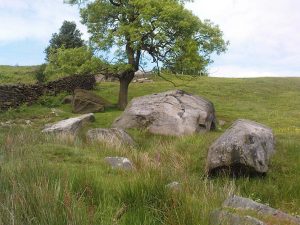Healing Well: OS Grid Reference – SE 0655 4413
Also Known as:
- Peggy Mawson’s Well
- Peggy’s Well

From Riddlesden, take the road up to the moorland and Rivock Edge. When you reach the top (Silsden Road), turn left. Go on for about 600 yards till you reach the lovely tree-hidden old cottages of Holden Gate, on your right. Stop — and walk down the footpath opposite from here. As the wall goes down, you’ll notice a stream in the next field to your left, emerging from a clump of large rocks. That’s it! (there’s a footpath in the next field from the roadside)
Archaeology & History
Shown on the first OS-map as ‘Peggy Mawson’s Well,’ little else seems to known of this place; though it obviously got its name after the local lady, Peggy Mawson. I can find no further information about this lady, nor why the site was named after her. Any help here would be hugely appreciated!

Sadly the waters from beneath the rocks have been channeled into a couple of pipes and the well no longer runs. All that’s left is a small boggy region just in front of the boulders. You have to walk about 100 yards further down the field where the water emerges from a modern pipe. It doesn’t taste as nice as it originally did when coming straight from the ground, but it’s still quite drinkable (certainly beats any of the chlorinated stuff* that customers are forced to pay for, whether we want it or not – and most people don’t want it).
Folklore
This site has acquired modern folklore, but sadly no early traditions have been found. Whelan & Taylor (1989) thought that Peggy Well’s “dedication suggests a connection with St. Margaret,” which unfortunately isn’t the case. Several years later another writer, Val Shepherd (1994), spun the speculation even further, not checking the historical background to the site, and thought that “the well’s name may be derived from the water spirit, ‘Peg,’ who gave her name to other wells.” Sadly neither idea holds any sway.
References:
- Shepherd, Val, Historic Wells in and Around Bradford, HOAP: Loughborough 1994.
- Whelan, Edna & Taylor, Ian, Yorkshire Holy Wells and Sacred Springs, Northern Lights: Pocklington 1989.
* Anyone know about this: surely because the water companies chlorinate and add other undesirable toxins into our tap water, what we’re actually drinking is a very weak solution and not actually water. Isn’t that a trading standards violation?
© Paul Bennett, The Northern Antiquarian
The map could not be loaded. Please contact the site owner.
With regards waters, it would be most unusual if any tap or spring water were to be “pure”, by the scientific definition thereof. Tap water, spring water and lake waters are all weak solutions of sodium, potassium, calcium and other salts, the other part being chloride, carbonate and so on. There are even scientific recipes for artificial tap water and artificial lake water; I used a recipe for the latter whilst doing a PhD on soil-living nematodes.
All soil-living animals need water, but pure distilled water obviously lacks the aforementioned salts, and causes soil-living and freshwater animals distress and harm from osmotic effects. Tap water, once dechlorinated, is usually OK but does tend to vary a very great deal from place to place and over time. A man in Newcastle University discovered this some decades ago whilst doing research on freshwater mussels, so he devised Artificial Tap Water. This is a set of three stock solutions, several millilitres of each of which are measured into a litre of distilled pure water, stirring well after each addition; my former PhD supervisor Dr Rolo Perry studied at Newcastle himself and took up this recipe; it has been quoted as a methods paper in almost all of Rolo’s work since and has a truly staggering citation rate for a middling piece of research (with a useful method in it).
You are however correct about water chlorination, as I know from bitter experience. My work entailed collecting large numbers of soil-living plant parasites, and to do this I ended up growing them on plant roots in hydroponic culture, which uses lots of water. Tap water sufficed until the local water company decided to give their pipe system a good clear-out one fine summer, and super-chlorinated the water. My potato plants were most distressed by this, and the parasites all died, clobbering several weeks of work.
I was saved here by a certain John Dingley, a highly skilled technician I knew, whose main claim to fame was managing to breed axolotls in captivity. He did so by virtue of the local water (Aberystwyth in Wales) being extremely pure, once you remove the chlorine. Doing so is easy once you know; put tap water in a big storage tank and bubble air through it for at least twelve hours; that shifts the chlorine without contaminating the water. It works a treat, and improves the flavour of the water, too.
Ultra-pure water was also a prerequisite of my research. There’re a couple of ways of getting this stuff; buy it in from a chemicals company like Rathburn or Fison’s, or run twice-distilled water through a Milli-Q ultrapurification unit. The water out of such a machine is just that; water, just water, and nothing but water. Tasteless, odourless and very, very pure.
Hi Dan –
Cheers for the comment. I didn’t say, nor infer, that water was pure. My point here is that we as humans have drank water from the Earth for a million years or so, and our biosystems have coped incredibly well and evolved as a result of Nature’s own water. Pure water, as far as I’m aware, doesn’t occur naturally on Earth (does it?), as rocks, soil and other ecological ingredients give vitality and differences to the springs, streams and cave pools all over the Earth. The recent “scientific recipes for artificial tap water and artificial lake water” might be OK for schoolboy experiments, or dealing with nuclear issues; but humans and the rest of the living things on Earth have survived eloquently with the waters that Earth provides, with and without microbes floating in their natural environment, since the year dot. Drinking water doesn’t need changing, or having stuff added to it. Does it?
Most educated people as I’m sure you know, want water untreated as it comes from the ground, as all living species have drank it until only very recently – and NOT the artificial ‘solution’ which chemists and PR-men in water companies tell us is best (colgate teeth smiling with their glossly insincerity to us poor customers). It’s open for abuse (fluoride for example) and we simply don’t want it. Do you think it’s OK?
Cheers – Paul
PS – your mate who was breeding axolotls…..they’re incredible creatures! Hope he was looking after the little fellas. Typically, humans are killing them off with their negligent disregard of the natural world.